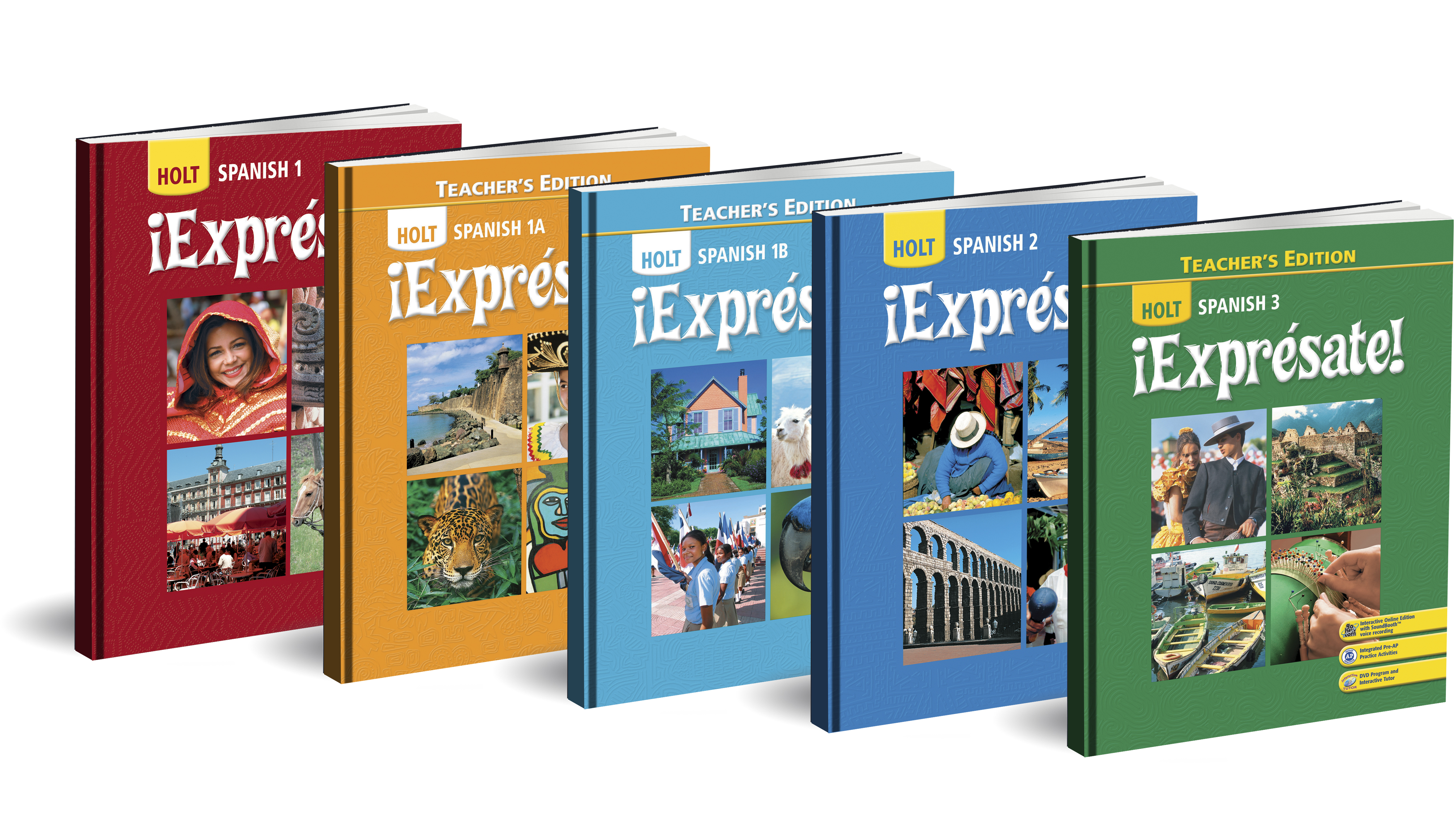What do you do when you’re being forced into a textbook adoption that’s stifling the creative community in your school? Sometimes you turn to someone with a generally poor opinion of textbooks for advice.
One of my favorite parts of doing what I do is the conversations I get to watch and sometimes even facilitate. I’m not in the classroom this year, and I do miss it like a drug some days, but I’m coming to see that where I am now, I can still contribute significantly to the field, mostly through you.
When I get questions and comments through the blog, your immediate need is for advice or direction and my (sometimes not very immediate) response is to try to speak some wisdom into your situation. But in the bigger picture, the questions you ask me and dilemmas you face and tell me about end up affecting teachers far and wide, because two months down the road at a workshop someone says,
I have this class where I try X and it’s not working. What do I do?
And I say,
I talked with a teacher in this exact situation 2 months ago! So she said that you should A, B, and L.
And so, because you reached out to me with your experience, you contributed to the profession in a way that may not have occurred to you.
A striking example of this streamed through my email recently. Because of the sensitivity of the situations these teachers are in, I have changed their names and some details here. All of them have previewed and approved this post because they want to help you, should you find yourself in this situation.
I apologize for the massive wall of text that is this post, but as soon as I saw this exchange happen, I knew I had to share it with those of you who find yourselves faced with a textbook adoption, wanted or unwanted. If it applies to you, you’ll be fascinated by the feedback; if not, if you’re blessed to be a department of one and/or have a lot of freedom thanks to supportive (or indifferent) administration, count your blessings and skip this one.
Round 1: Any change is a solution
Sometime last year, I was contacted by Marlene, who teaches Spanish in a large high school in a department of about seven or eight teachers with widely varying stands on communicative language teaching. She and her colleagues had done some work on creating assessments, wanted to create common units, and then, bam- a push to adopt a new textbook:
On the theme of books: I am feeling stressed. I feel like once we get new books, it will be a race by most to create everything new like vocab lists, vocab quizzes, and then the real assessments will be put on hold or have less quality. I am not condoning vocab quizzes, but some aren’t ready to let them go.
My take on the books is we have Exprésate and we are familiar with it. There is a learning curve with new books. Maybe we can’t do all the units quickly, but at least if we keep our books, it will be easier to create units. We already have some decent assessments in Spanish I. If we adopt a book, we have to get to know the book first and then we mine it for what to keep and use. Then creating units might get delayed for even longer. I know the key is assessment. To me, new book=less time to focus on real change.
I really think people want new books because they want a change. They like books, so they like new books. The two best sellers didn’t change since the last round of adoptions, and Descubre was written for a university audience marketed to high school. I don’t know if that’s a bad thing or not.
When what you’re doing isn’t working, it seems like any big change will be the solution, right? And a shiny, expensive new textbook with all its techy add-ons and convenient pacing guides seems like the easiest big change that will solve everything.
 Honestly, I don’t have a lot to say about specific textbooks because I haven’t used one in years. So, I turned to a friend who was supposed to be using one and whose opinion I trusted. Here’s what Brittany had to say:
Honestly, I don’t have a lot to say about specific textbooks because I haven’t used one in years. So, I turned to a friend who was supposed to be using one and whose opinion I trusted. Here’s what Brittany had to say:
I would use the Descubre series if I had to select one. I have used several things from them in my non-textbook classes, and I think I would use them more if I had them. I like that the activities are progressively more challenging, yet attainable. Our French teacher got the French editions for her IB classes, and the online resources were amazing–films, audio clips, testing, etc., and all with a proficiency focus. Grammar is for communication, not just for grammar’s sake.
Info and demo here: http://descubre1.vhlcentral.com/demo/ They are really good about sending sample copies.
They also have upper level stuff that is intriguing and good to work with. I sample stuff from those resources too.
To me, it’s the polar opposite of what we currently have, Realidades. THAT book hasn’t left the shelf all year. Descubre is still a text, and isn’t perfect, but I feel that I can make it work as a well-made tool. I have heard some teachers say that they find it challenging to use, but in further discussions, it seemed that they weren’t doing anything more than the publisher’s activities. I’m thinking it’s pretty safe to say that we wouldn’t do that–that we would use the text to help with core support, but we’d be using other resources to help pull it all together. Also, there is so provided material that I think that they got bogged down trying to do it all.
Isn’t that the answer, after all? That a textbook is simply a tool, and the real answer is you, and what you do with it. Like she said, a tool that’s well-made can make a big difference.
Marlene’s school ended up adopting Descubre.
Round 2: Get a textbook, and do it now
Fast forward some to an email I got from another friend, Angela, who has more experience teaching than I do, currently teaching intermediate students. Her department was not only being forced into a textbook adoption, but at first was being greatly rushed into it:
I don’t think a textbook is a good use of money. I’ve seen lots of teachers and departments design curriculum successfully and share their assessments online. But the reality is we have a tight deadline to do so and we must select a textbook series for our first two levels, maybe the third too. Teachers think that ‘simply’ adopting a new textbook will bring great ease and less work. Any change will bring lots of work. And this change is being rushed… it’s discouraging. The task is overwhelming and the textbook options are underwhelming. Could you please recommend a textbook for us to consider?
It’s months later but I still don’t have an answer for this question. And I’m not even teaching now, much less using a textbook. So what do I do? Well, I put them together of course.
And as a side note, the only advice I really had to offer was that if they adopted Realidades that they could refer to Andrea over at Lugar para pensar to figure out how to incorporate it into a more communicative program.
 Descubre: Feedback from the stakeholders
Descubre: Feedback from the stakeholders
Thankfully, Marlene went above and beyond in her response, contributing far more to the textbook discussion than I could. She even surveyed her department to get feedback from them, too. The work she put into helping Angela in this situation is what inspired me to write this post.
First, she explained their school situation. At their school, students have a class:
-
for a trimester
-
which is 12 weeks long
-
with classes every day
-
lasting about 70 minutes each.
Which adds up to a level of Spanish being:
-
24 weeks divided into two 12-week trimesters
-
which may or may not be consecutive
-
and which may or may not be from the same teacher
-
and students could have four different teachers for two levels of Spanish.
Their department did end up adopting Descubre, an this is the breakdown:
-
Book 1A for Spanish 1
-
Book 1B for Spanish 2
-
Descubre 2 for Spanish 3
-
Descubre 3 for Spanish 4
In her reflection, she believes that Spanish 4 should be using Descubre 2 and not the third book.
 Marlene isn’t a fan of Descubre, as you’ll see.
Marlene isn’t a fan of Descubre, as you’ll see.
My opinion is we should have chosen Así se dice 1A and 1B or Realidades 1A and 1B for Spanish I and II. To adopt Así se dice, I needed department support I didn’t have.
Realidades has a really good feature in the newest version where there is video support that models the communicative activities. I also LOVED their map features with the geoculture. But in our textbook-driven department, teachers didn’t like that it hasn’t been updated much, so it seems old. Also, even with splitting the the textbooks by using the junior high version, there are a lot of chapters.
Choosing a textbook, especially when you don’t want one at all, is a tough decision, as you can tell. Marlene still wishes they would have simply re-adopted Exprésate. Perhaps if the other teachers simply got new copies to replace their worn-out copies they would have been satisfied.
So what have they thought about using Descubre since they adopted it this year? Marlene says about the content:
The vendor does not tell you, and you need to know, that this textbook was written for a college/university audience originally. Some of the prompts support that statement for example…pretend you are on a date, tell your roommate, talk about your courses which are part of the vocabulary, but are the type of courses a university student takes. Lesson 2 is about a college life.
What about how you schedule the curriculum?
Whether you are on trimester or traditional scheduling, I am in favor of a 1A & 1B for any of the textbooks for Spanish I and II. This will help with the problem of trying to teach too much in one school year (and even with the split there is too much), and will allow room for a lot more proficiency-based tasks and supplementing with authentic resources if your teachers are so inspired.
One of Marlene’s colleagues, a teacher committed to proficiency-based teaching, chimed in with her perspective on using Descubre in level 1.
I supplement with a lot of authentic materials like music videos and commercials. I don’t find much of the textbook useful. I only use the workbook because my students could end up with another teacher the next trimester who will know I didn’t use it, so I do. But there’s too much vocabulary and too many activities. The communicative activities that are in the book, we don’t use them because they are too difficult for novices so I supplement those too.
On the higher levels, she can’t tell you a whole lot about how Descubre works there:
I rarely use a textbook. For levels 3 and 4, I barely use it, so I can’t speak of its communicative capacities or the authenticity of its resources. I know Descubre 3 has some great things, but I haven’t used them yet. I only use it to find an alignment to something I am teaching with units. So I decide what I am going to teach, and then I go to the book to find something related and I put it in my scope and sequence. I regret even ordering the book for Spanish III and IV because they are paying for a book that isn’t used.
(Did you catch how her whole perspective is that it’s a tool, and it’s not the curriculum?)
How helpful would it be to hear from the students using Descubre? Marlene’s a wonder and she’s got that feedback for you too. Here’s what the kids say (if you teach teenagers you’ll read well into these statements, I’m sure!):
-
There are too many words.
-
It’s kind of difficult.
-
It’s helpful.
-
There are no study materials.
-
It’s confusing sometimes.
-
When you just read it, you don’t understand, so somebody has to explain it to you.
-
It needs better pictures.
-
I like it.
-
It needs more English.
Marlene is a teacher 100% sold on proficiency-based, communicative teaching through authentic resources. What about teachers who don’t land so much in that camp? Here’s their feedback:
The testing program has been harder to modify because of software issues, but if you like the tests/quizzes as they are, then you won’t have a problem. The online components have been fantastic, but will require some getting used to for both students and teacher. If you’re using them for graded assignments, you must schedule regular in-class lab time with teacher available to answer questions. Transitioning for 2nd year students has been a bit of a challenge, but I think that would be the case for any textbook. Pacing can still be a challenge, but we are always rushed on a trimester. There seem to be a lot of places where you can combine concepts easily. As with all textbooks, you have to pick and choose which activities are most effective for your particular classes.
I am very happy with it and have found that I need to supplement less than usual.
If nothing else, the online activities are great when we are able to use them. Since we can do half as much as we were before, we are able to go a lot slower.
The book is ok. It’s not great, some of the activities are a little difficult and/or require too much teacher help, so it’s not something I can give them to work on. The reason I like those types of activities are that I can help the struggling students and the ones that aren’t struggling can move on or I can make it more challenging for them.
I really like it!
Angela especially appreciated and benefited from Marlene’s input because as it turns out, they are on the same trimester schedule. Angela says,
They feel like little tourists in our classrooms – here for 60 days and then on to the next teacher (or on to a trimester off).
Descubre was high on the list of recommendations for Angela’s school’s textbook adoptions and seemed at first like a positive choice:
The positive feedback we’d heard had everyone very hopeful. We had heard that the materials were authentic.
But sometimes in spite of the hype and flashy conference booths, a program is not the all-encompassing solution it seems to be:
We looked at the topics inside the front flap that shows all three levels and we looked at the assessment and video examples they sent us.
Among the red flags that immediately perked Angela’s suspicions:
-
4 grammar topics per chapter (covering too much content, anyone?)
Marlene: there’s a lot in those four topics. -
less than impressive assessments
Marlene: but you can create your own with a good team -
a clearly different definition of “authentic”
Marlene: some are authentic, especially the commercials, but Exprésate‘s “Comparaciones” is better than “Flash Cultura”
 It’s a situation that’s so sad but all too common. Angela’s department, thankfully, decided at least to take a little more time on their decision, but how often do schools come to this crossroads where they could take a path driven by stakeholder input – especially, what the students need; or they could choose what perhaps seems the easiest way, and take the road highly traveled that fills seat time, gets everyone a paycheck, and doesn’t rock the boat. And too many departments make that second choice.
It’s a situation that’s so sad but all too common. Angela’s department, thankfully, decided at least to take a little more time on their decision, but how often do schools come to this crossroads where they could take a path driven by stakeholder input – especially, what the students need; or they could choose what perhaps seems the easiest way, and take the road highly traveled that fills seat time, gets everyone a paycheck, and doesn’t rock the boat. And too many departments make that second choice.
If you’re in the same situation, and Angela and Marlene could talk to you now, here’s the advice they would have for you:
-
Know when to ease up and when to press your point.
-
Ask the questions that will lead to more administrative support; it makes a huge difference.
-
Ask the questions that will lead to more teacher buy-in; it makes a huge difference.
To wrap it up, here’s my two cents: remember that whether or not a textbook exists in your classroom is not the issue; the important thing is how teachers implement the tools they have.
-
To work toward being a more effective teacher, explore the great content over at the TELL project.
-
Watch for an upcoming post related to one of my conference proposals for this year- AID: a three-pronged approach to textbook content, Adapt, Incorporate, Ditch.
-
To work with a small group of teachers on planning your curriculum for next year from the big picture to the day-to-day routine, whether or not you incorporate a textbook, consider joining us for a one- or two-day workshop at Camp Musicuentos, this year in Louisville, KY (currently very limited space on the novice day, intermediate day on a wait list), and Warwick, RI (six spaces remaining).
No matter what your department does, you can always push for more latitude, do more of your own thing, and then show off your results. Your students’ success will always be your biggest advocate.
7 Comments
Comments are closed.





[…] Cottrell mentioned me in a post she wrote about textbooks, so I thought I’d write about how I use Realidades, and what strategies help me incorporate […]
Great post! I really feel for those teachers who have to adopt textbooks. As far as textbooks are concerned, I have always been impressed with Vista Higher Learning. I “adopted” Temas for my AP Spanish Language and Culture course. Así se dice makes me cringe! My department adopted it about seven years ago. What was their reasoning? It was the newest version of Buen Viaje, which they had used for years and years (and wouldn’t have to throw away their lesson plans). *cringe* But, hey, they are all my dear friends and that’s what they wanted in order to make their lives easier!
This is fascinating. What I takeaway from this is that no matter what, it’s going to take a lot of work. I used to think a new textbook would be a solution, but attending #langchat and #campmusicuentos changed me, and I’m moving towards this new paradigm.
Sara Elizabeth has helped me with posts like these: http://musicuentos.com/2013/03/eveneasier/, where she encourages you take baby steps in the direction you want to go.
[…] all textbooks or their activities are created equal. If you’re incorporating a textbook (or forced to adopt and use one like these teachers), keep […]
I am STRONGLY opposed to Descubre, which we have just purchased. It is by far the worst textbook for Middle School students learning Level 1 Spanish. The “school day” vocabulary requires students to learn “accounting, psychology, economics, student residence, physics” and other ridiculous words that they do not even understand in English or are not applicable at all. Ready for the practice activity to accompany this lesson? Hey kids, can you match the name “Carl Jung” with the correct class? Good luck teachers, this book is the WORST I have ever seen. The website is entirely in Spanish, opposite of user-friendly, and it constantly marks student answers wrong for not capitalizing single-word answers. The kids can NEVER find anything without me writing a list of about 10 steps. The videos look like they were filmed using a camera with 100 pixels total. The photos are poor quality and the book layout is boring and examples are not clear. The speakers are very difficult to follow and the “plots” make me want to cry. The last one I tried to show was a group of college students randomly talking about their classes and then a joke that went like this: “So, why am I taking computation?” Answer: “Because you like homework.” I am beyond disgusted with this book. Give me REALIDADES back!! Realidades allowed for TPR, games, CONVERSATIONS using the vocabulary, CONTEXTUALIZED scenarios and I was able to do almost ALL of the class activities with ease. Lastly, Pearson is also the company that creates all of the country’s standardized tests (PSSAs) so their format is “the” format that the kids need to be familiar with anyway.
Thanks so much for this feedback “from the trenches” Jess!
[…] 8. Forced to adopt a textbook: Now what? […]